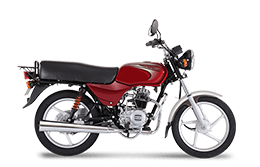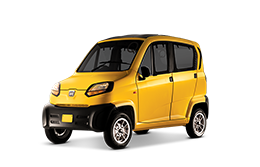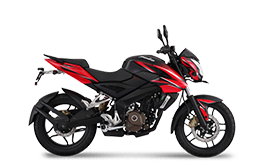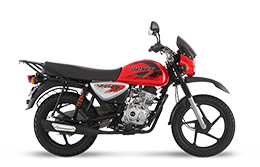Autocar India
We’ve just put the Pulsar RS 200 through our complete road test treatment to tell you how Bajaj’s first fully faired bike performs.
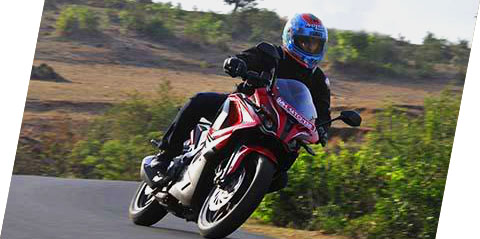 Bajaj has put in several R&D months perfecting the RS 200, the Indian bike major’s first fully faired Pulsar. The bike is the latest entrant in the mini supersports class here in India. This segment today has only a handful of options, which are often pricey. So, a well-priced option in the segment is sure to encourage new buyers seeking thrills and this is where Bajaj would like to capitalize, with the introduction of its RS 200.
Bajaj has put in several R&D months perfecting the RS 200, the Indian bike major’s first fully faired Pulsar. The bike is the latest entrant in the mini supersports class here in India. This segment today has only a handful of options, which are often pricey. So, a well-priced option in the segment is sure to encourage new buyers seeking thrills and this is where Bajaj would like to capitalize, with the introduction of its RS 200.To see the light of success however, Bajaj needs to offer a lot, which includes the right combination of power, comfort and handling all in a good looking package. Can the Pulsar RS 200 make the cut?
Design: The Pulsar RS 200's sportsbike looks are contemporary, but really busy and flashy, making this a bike that is not going to appeal to conservative buyers. A wide, see through visor sits in front offering a clear view ahead at night. The twin headlights do a brilliant job of lighting the road ahead, just as on previous Pulsars.
A raised, clip-on handlebar finds place here. Bajaj also provides handlebar-end weights to reduce vibrations as much as possible. Grips are soft to touch and work, feeling comfortable even when riding without riding gloves. Dog-leg and black powder coated levers likewise feel good to operate. Mirrors work decently well when astride offering good rear view. Blue-illuminated switchgear is part of the package, Bajaj providing a useful engine kill switch on the right too.
The blue luminous digi-analogue console displays a bright orange over-rev warning light, flashing out its message before the engine rev-limiter kicks in. A subtle side-stand engaged indicator is also provided for extra safety.
Bajaj provides LED power for the Pulsar RS 200, including for the parking lights, turn signal indicators and rear tail-light. The taillight itself is a free formed cluster that looks a bit over the top.
The RS 200 is rather colourful, with parts such as a golden crankcase, alloy pegs and a dual-tone paint scheme.
The well designed and flat-top fuel-tank’s filler cap comes with a hinge. There’s thoughtfully provided scratch protection for the tank. A well-contoured split saddle makes its way here; on each side of the longish and well-designed rear panels are in-built grab handles. A triangular, stubby and well-rounded end-can, along with the Pulsar typical 10-spoke alloy wheels also add to the RS’ sporty appeal.
Overall quality and fit-finish are all satisfactory, the Bajaj bike feeling well built.
Engine: Bajaj provides a well suited powerplant on the Pulsar RS 200. The basic engine architecture remains in common with the Pulsar 200NS, but in a new state of tune, along with the addition of fuel-injection. The Pulsar RS 200 has a 199.5cc, four-stroke, single-cylinder and liquid-cooled engine that now makes slightly more power, 24.2bhp at 9,750rpm, and 1.9kgm of torque at 8,000rpm.
The new Pulsar comes with a four valve-per-cylinder head with single overhead camshaft drive. The RS 200 also uses Bajaj’s patented triple-spark technology. The clutch has a well-weighted feel, and the six-speed gearbox shifts precisely, in a one-down, five-up pattern via a toe-shift lever.
The RS 200 is good for sustained cruising on the highway at an indicated 110kph. It's a quick bike and can sprint to 60kph in a respectable 3.76 seconds, thereafter achieving 100kph in 9.71secs. We achieved a true top speed of 137kph, the engine achieving maximum rpm in sixth gear. The fairing works well, helping the rider to achieve high speeds thanks to its thoughtful aerodynamics.
Throttle response is nice, and the power delivery smooth. The Pulsar RS 200 is a really refined motorcycle. The RS 200 has a wide powerband, performance output in a nice, linear flow, although in typical sportsbike territory, Bajaj has kept this a really fun bike to ride, with performance best when up-shifting with the revs nudging redline territory. The Pulsar RS 200 lives up to its sporty tag, with a heady, intoxicating rasp emitted at the silencer when riding at high speed, and the high revving engine performs at its best when ridden at the race track. Bajaj has engineered the bike to make you want to ride hard, and fast. The RS 200 easily lives up to being the sportiest of all Pulsars to date.
Ride & Handling: The Pulsar RS 200 gets the tried-and-tested twin-spar, steel fabricated frame from the 200NS. The kerb weight is a shade on the heavier side, at 165kg, although this is not a bother when on the go.
The rider sits upright on the Pulsar RS 200 but with a little lean into the handlebars, not unduly straining the wrists. Bajaj provides the Pulsar RS 200 with a well-padded, roomy split saddle, which is comfortable enough for a bike with such sporty nature.
A pair of 37mm hydraulic, telescopic forks are seen upfront and an eight-step adjustable, gas-filled monoshock absorber is provided at rear. Ride quality is good, neither too soft, nor overly firm. The Pulsar RS 200 absorbs bumps well, with a nice, sporty and firm feel, the new Bajaj bike remaining nicely settled while negotiating undulations mid corner as well.
A delight when cornering, the Pulsar holds its line well due to its taut suspension and this is further enhanced thanks to really grippy MRF rubber. The Pulsar RS 200 is an agile handling motorcycle, not quite as quick to turn in and flick around precisely as KTM’s RC200, but then again, providing more comfort than any of its Austrian siblings.
Snail-cams are used to adjust its exposed O-ring sealed drive chain, the RS 200 one of few Indian motorcycles to benefit from such a system.
This is the first Bajaj motorcycle to offer the added safety of ABS brakes, although this is via single channel, working well but only for the front wheel. The front end has a 300mm petal type rotor, while the rear is equipped with a 230mm petal disc. We managed to get the bike to halt in a decent 17.96 meters, in 2.4 seconds.
Fuel & Economy: This time around, Bajaj has equipped the Pulsar RS 200 with fuel-injection, and along with its triple-spark technology, the bike managed fairly good fuel-economy. The RS 200 returned us a decent 34.2kpl in real world city riding conditions, this going up to 43kpl when cruising at more steady speeds out on the highway.
Verdict: Bajaj has created a motorcycle that is sure to appeal more to the younger generation, who appreciate and aspire for more flashy looking bikes. The Pulsar RS 200 is sure to provide a fair share of thrills for both, new and experienced riders, who will appreciate the bike for its largely versatile nature being sporty enough to head to the race track where it does hold its own and do Bajaj proud, while still being comfortable too. The engine is flexible enough to tackle bumper-to-bumper traffic and shifting through the six-speed gearbox at high revs is a pleasure out on open roads. The RS 200 is a capable tool for track days and the occasional ride out of town, a good leisure activity for many. Having ridden the bike on the race track and in traffic, we rate the RS 200 a good motorcycle. The entry level Pulsar RS 200 is priced at Rs 1,21,069, while the ABS equipped version costs Rs 1,33,094 (ex-showroom, Pune), at which the RS 200 makes a competent rival in its class.
The following review has been sourced from Autocar India - May 2015.
A raised, clip-on handlebar finds place here. Bajaj also provides handlebar-end weights to reduce vibrations as much as possible. Grips are soft to touch and work, feeling comfortable even when riding without riding gloves. Dog-leg and black powder coated levers likewise feel good to operate. Mirrors work decently well when astride offering good rear view. Blue-illuminated switchgear is part of the package, Bajaj providing a useful engine kill switch on the right too.
The blue luminous digi-analogue console displays a bright orange over-rev warning light, flashing out its message before the engine rev-limiter kicks in. A subtle side-stand engaged indicator is also provided for extra safety.
Bajaj provides LED power for the Pulsar RS 200, including for the parking lights, turn signal indicators and rear tail-light. The taillight itself is a free formed cluster that looks a bit over the top.
The RS 200 is rather colourful, with parts such as a golden crankcase, alloy pegs and a dual-tone paint scheme.
The well designed and flat-top fuel-tank’s filler cap comes with a hinge. There’s thoughtfully provided scratch protection for the tank. A well-contoured split saddle makes its way here; on each side of the longish and well-designed rear panels are in-built grab handles. A triangular, stubby and well-rounded end-can, along with the Pulsar typical 10-spoke alloy wheels also add to the RS’ sporty appeal.
Overall quality and fit-finish are all satisfactory, the Bajaj bike feeling well built.
Engine: Bajaj provides a well suited powerplant on the Pulsar RS 200. The basic engine architecture remains in common with the Pulsar 200NS, but in a new state of tune, along with the addition of fuel-injection. The Pulsar RS 200 has a 199.5cc, four-stroke, single-cylinder and liquid-cooled engine that now makes slightly more power, 24.2bhp at 9,750rpm, and 1.9kgm of torque at 8,000rpm.
The new Pulsar comes with a four valve-per-cylinder head with single overhead camshaft drive. The RS 200 also uses Bajaj’s patented triple-spark technology. The clutch has a well-weighted feel, and the six-speed gearbox shifts precisely, in a one-down, five-up pattern via a toe-shift lever.
The RS 200 is good for sustained cruising on the highway at an indicated 110kph. It's a quick bike and can sprint to 60kph in a respectable 3.76 seconds, thereafter achieving 100kph in 9.71secs. We achieved a true top speed of 137kph, the engine achieving maximum rpm in sixth gear. The fairing works well, helping the rider to achieve high speeds thanks to its thoughtful aerodynamics.
Throttle response is nice, and the power delivery smooth. The Pulsar RS 200 is a really refined motorcycle. The RS 200 has a wide powerband, performance output in a nice, linear flow, although in typical sportsbike territory, Bajaj has kept this a really fun bike to ride, with performance best when up-shifting with the revs nudging redline territory. The Pulsar RS 200 lives up to its sporty tag, with a heady, intoxicating rasp emitted at the silencer when riding at high speed, and the high revving engine performs at its best when ridden at the race track. Bajaj has engineered the bike to make you want to ride hard, and fast. The RS 200 easily lives up to being the sportiest of all Pulsars to date.
Ride & Handling: The Pulsar RS 200 gets the tried-and-tested twin-spar, steel fabricated frame from the 200NS. The kerb weight is a shade on the heavier side, at 165kg, although this is not a bother when on the go.
The rider sits upright on the Pulsar RS 200 but with a little lean into the handlebars, not unduly straining the wrists. Bajaj provides the Pulsar RS 200 with a well-padded, roomy split saddle, which is comfortable enough for a bike with such sporty nature.
A pair of 37mm hydraulic, telescopic forks are seen upfront and an eight-step adjustable, gas-filled monoshock absorber is provided at rear. Ride quality is good, neither too soft, nor overly firm. The Pulsar RS 200 absorbs bumps well, with a nice, sporty and firm feel, the new Bajaj bike remaining nicely settled while negotiating undulations mid corner as well.
A delight when cornering, the Pulsar holds its line well due to its taut suspension and this is further enhanced thanks to really grippy MRF rubber. The Pulsar RS 200 is an agile handling motorcycle, not quite as quick to turn in and flick around precisely as KTM’s RC200, but then again, providing more comfort than any of its Austrian siblings.
Snail-cams are used to adjust its exposed O-ring sealed drive chain, the RS 200 one of few Indian motorcycles to benefit from such a system.
This is the first Bajaj motorcycle to offer the added safety of ABS brakes, although this is via single channel, working well but only for the front wheel. The front end has a 300mm petal type rotor, while the rear is equipped with a 230mm petal disc. We managed to get the bike to halt in a decent 17.96 meters, in 2.4 seconds.
Fuel & Economy: This time around, Bajaj has equipped the Pulsar RS 200 with fuel-injection, and along with its triple-spark technology, the bike managed fairly good fuel-economy. The RS 200 returned us a decent 34.2kpl in real world city riding conditions, this going up to 43kpl when cruising at more steady speeds out on the highway.
Verdict: Bajaj has created a motorcycle that is sure to appeal more to the younger generation, who appreciate and aspire for more flashy looking bikes. The Pulsar RS 200 is sure to provide a fair share of thrills for both, new and experienced riders, who will appreciate the bike for its largely versatile nature being sporty enough to head to the race track where it does hold its own and do Bajaj proud, while still being comfortable too. The engine is flexible enough to tackle bumper-to-bumper traffic and shifting through the six-speed gearbox at high revs is a pleasure out on open roads. The RS 200 is a capable tool for track days and the occasional ride out of town, a good leisure activity for many. Having ridden the bike on the race track and in traffic, we rate the RS 200 a good motorcycle. The entry level Pulsar RS 200 is priced at Rs 1,21,069, while the ABS equipped version costs Rs 1,33,094 (ex-showroom, Pune), at which the RS 200 makes a competent rival in its class.
The following review has been sourced from Autocar India - May 2015.



